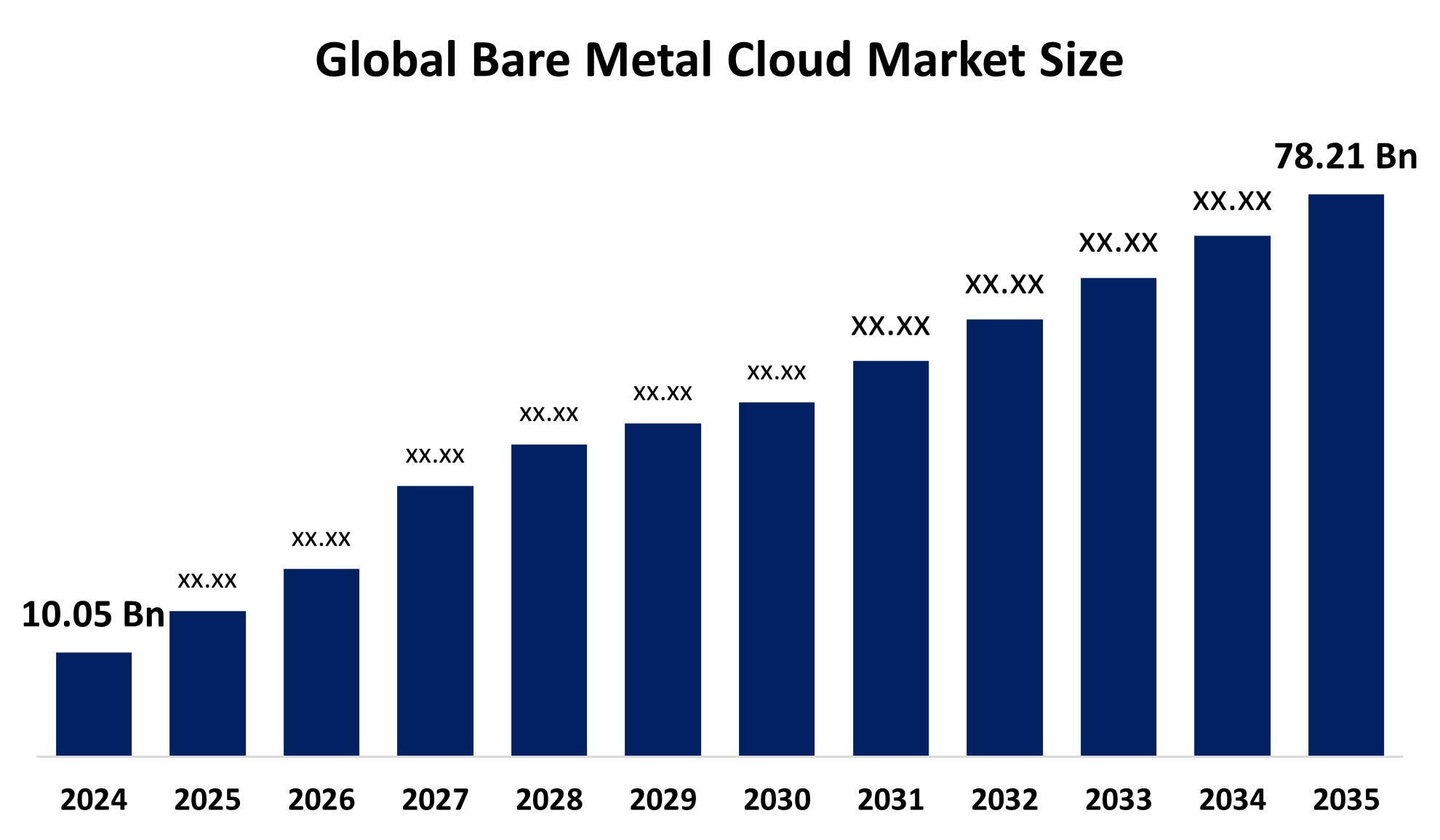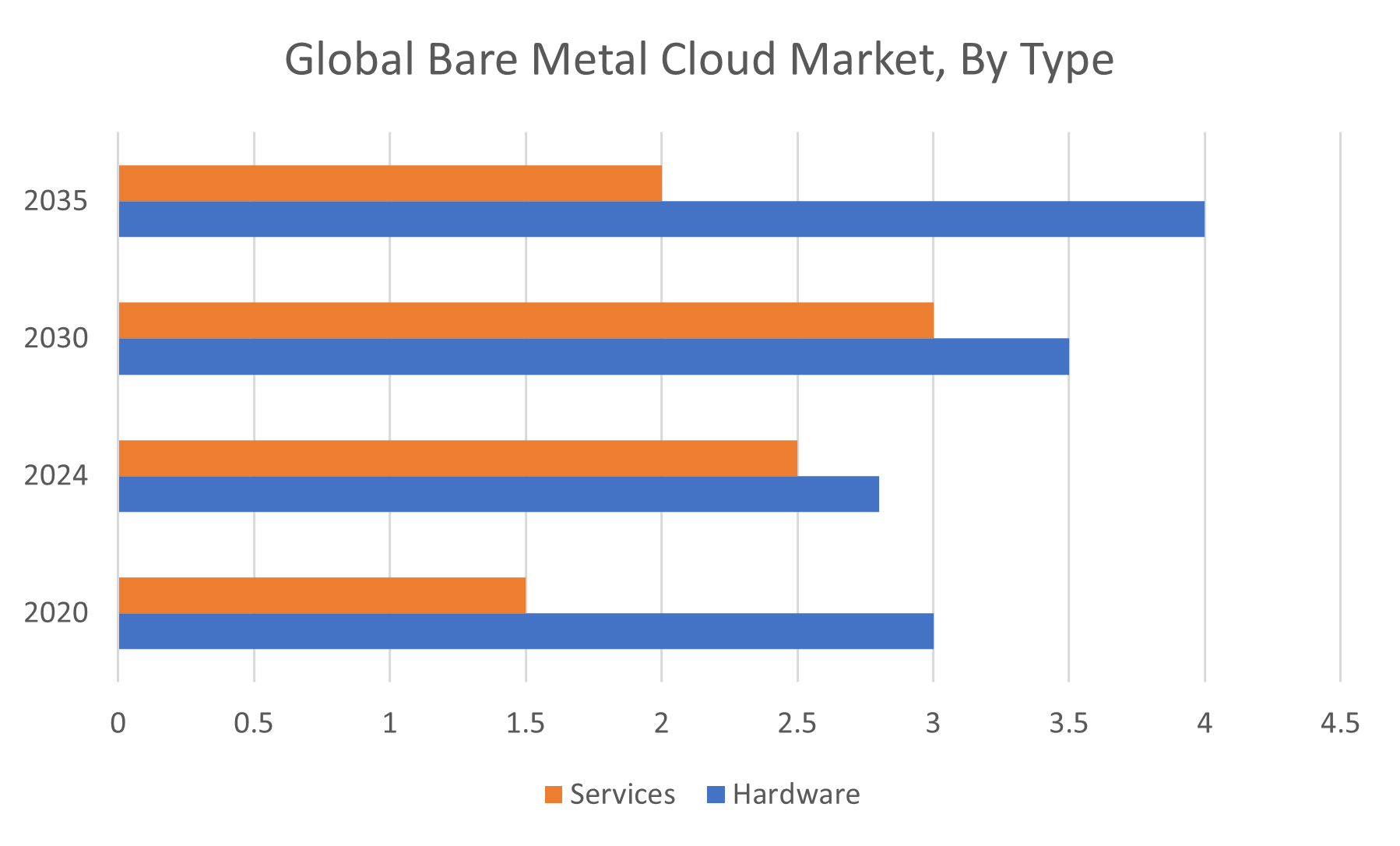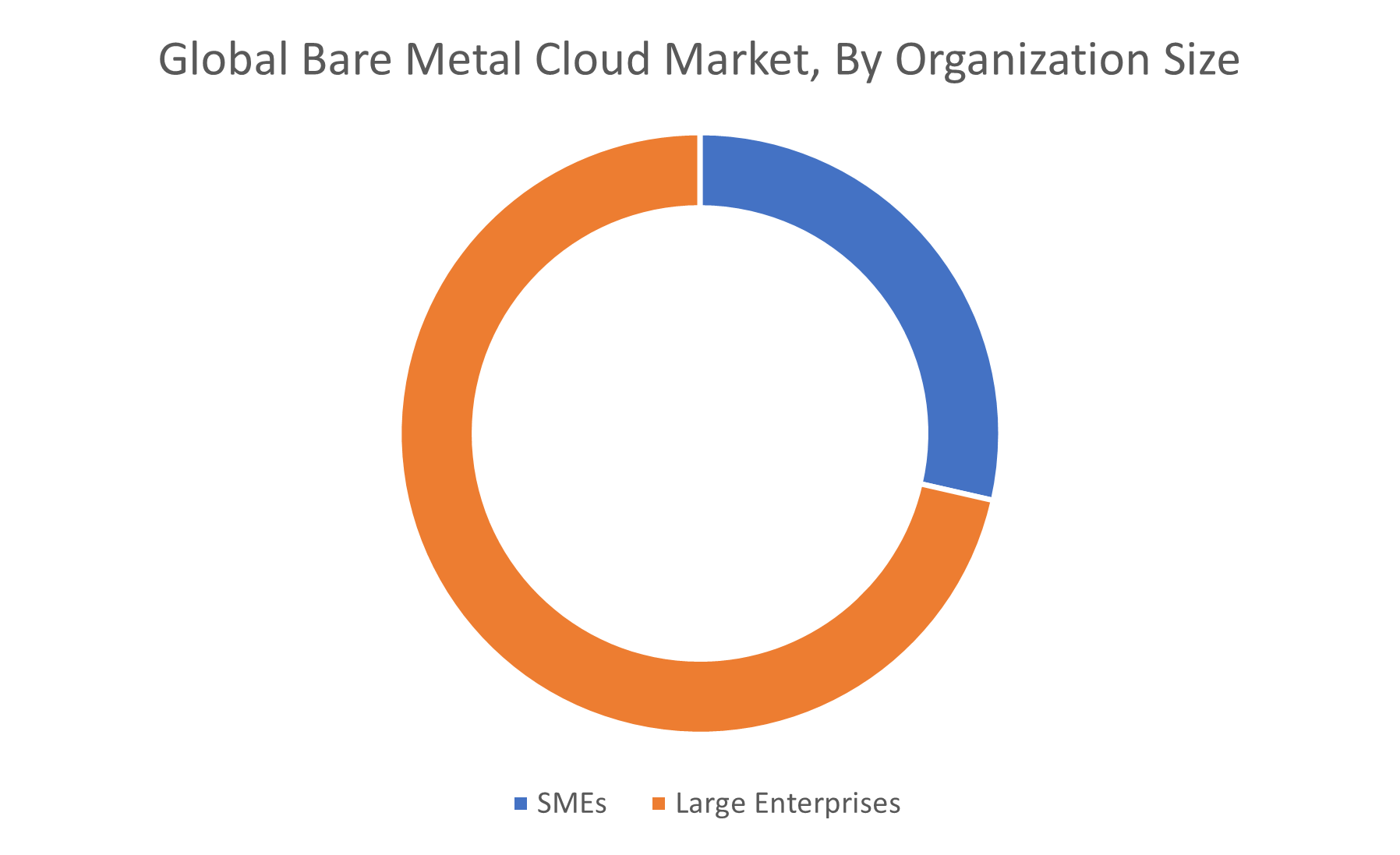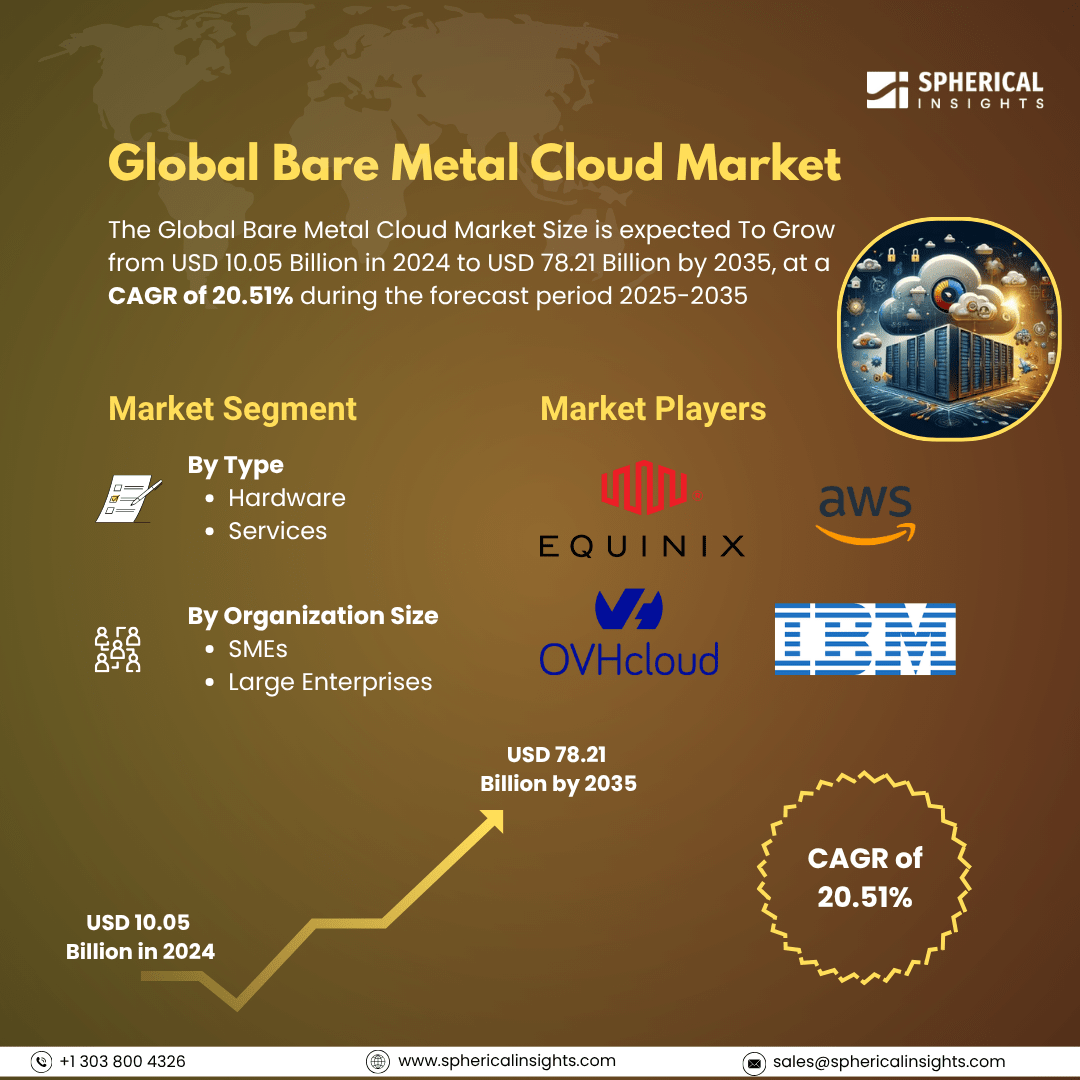Global Bare Metal Cloud Market Insights Forecasts to 2035
- The Global Bare Metal Cloud Market Size Was Estimated at USD 10.05 Billion in 2024
- The Market Size is Expected to Grow at a CAGR of around 20.51% from 2025 to 2035
- The Worldwide Bare Metal Cloud Market Size is Expected to Reach USD 78.21 Billion by 2035
- Asia Pacific is expected to grow the fastest during the forecast period.

Bare Metal Cloud Market
The Global Bare Metal Cloud Market encompasses cloud computing services that provide dedicated physical servers to users, allowing direct access to hardware without the use of virtualization. This setup delivers high-performance computing capabilities with greater control, security, and customization compared to traditional virtualized cloud environments. Bare metal cloud services enable businesses to run resource-intensive applications such as artificial intelligence, big data analytics, and high-frequency trading with improved speed and reliability. These services combine the flexibility of cloud infrastructure with the dedicated nature of physical servers, offering scalability alongside robust performance. The market includes a range of offerings from major cloud providers and specialized bare metal cloud vendors, often supported by extensive global data center networks. Industries such as finance, healthcare, gaming, and telecommunications utilize bare metal cloud solutions to meet their demanding operational needs.
Attractive Opportunities in the Bare Metal Cloud Market
- Demand for bare metal infrastructure near data sources enables ultra-low latency and real-time processing for IoT, autonomous vehicles, and smart applications.
- 5G rollout drives need for high-speed, data-intensive applications like smart cities and augmented reality, fueling demand for powerful bare metal cloud services.
- Automation tools simplify bare metal management, making these solutions more accessible to SMEs and easing operational complexity.
Global Bare Metal Cloud Market Dynamics
DRIVER: Increasing demand for high-performance computing and enhanced security in cloud environments
The growth of the global bare metal cloud market is primarily driven by the increasing demand for high-performance computing and enhanced security in cloud environments. As businesses adopt digital transformation strategies, they require infrastructure that supports resource-intensive workloads like artificial intelligence, machine learning, and big data analytics. Bare metal cloud offers direct access to physical servers, eliminating the overhead of virtualization and providing superior performance and low latency. Additionally, industries with strict regulatory and compliance requirements, such as finance and healthcare, prefer bare metal solutions for their enhanced data privacy and control. The rise of hybrid and multi-cloud strategies also fuels demand, as organizations seek flexible and scalable infrastructure options. Furthermore, the expanding adoption of cloud-native applications and containerization technologies encourages enterprises to leverage bare metal clouds for optimized resource allocation. Together, these factors contribute to the steady expansion of the bare metal cloud market worldwide.
RESTRAINT: Higher cost compared to traditional virtualized cloud services
One significant challenge is the higher cost compared to traditional virtualized cloud services, as dedicated hardware requires greater investment and management expenses. Additionally, the complexity involved in deploying and maintaining bare metal infrastructure can deter smaller businesses lacking specialized IT expertise. Unlike virtual machines, bare metal servers offer less flexibility for rapid scaling or resource adjustments, limiting their appeal for workloads with fluctuating demands. Integration with existing cloud ecosystems can also pose difficulties, especially for organizations heavily invested in virtualization technologies. Furthermore, concerns about vendor lock-in and limited availability of bare metal cloud services in certain geographic regions restrict widespread adoption. These factors collectively hinder the market’s growth despite the performance and security advantages that bare metal cloud solutions provide.
OPPORTUNITY: Growing adoption of edge computing creates a demand for bare metal infrastructure
The growing adoption of edge computing creates a demand for bare metal infrastructure closer to data sources, enabling ultra-low latency and real-time processing for applications like autonomous vehicles and IoT. Additionally, advancements in automation and orchestration tools offer opportunities to simplify bare metal cloud management, making it more accessible to a broader range of businesses. The expansion of 5G networks also opens new avenues for bare metal cloud services to support high-speed, data-intensive applications in sectors such as smart cities and augmented reality. Furthermore, increasing collaboration between bare metal providers and cloud-native platform developers can lead to more integrated hybrid solutions, blending the benefits of dedicated hardware with cloud flexibility. Lastly, emerging markets with growing digital infrastructure needs present untapped potential for bare metal cloud adoption, especially as enterprises seek localized, high-performance computing resources.
CHALLENGES: Slower provisioning time compared to virtualized cloud services
One major challenge is the slower provisioning time compared to virtualized cloud services, as physical servers require more time to deploy and configure, impacting agility. Additionally, the lack of standardized APIs and interoperability across different bare metal providers complicates integration with existing multi-cloud and hybrid cloud environments. Security concerns also persist, especially related to physical hardware vulnerabilities and the management of on-premises versus cloud infrastructure. Moreover, rapid technological advancements require continuous hardware upgrades, which can be capital-intensive and operationally demanding for providers. There is also a talent gap, as skilled professionals knowledgeable in bare metal cloud technologies and infrastructure automation are relatively scarce. Finally, the evolving regulatory landscape and data sovereignty laws introduce complexity in managing distributed bare metal infrastructure globally, posing compliance challenges for organizations operating across multiple regions.
Global Bare Metal Cloud Market Ecosystem Analysis
The global bare metal cloud market ecosystem includes service providers offering dedicated physical servers, supported by hardware manufacturers supplying essential infrastructure. Software vendors deliver automation and management tools, while cloud-native technology providers enable optimized workload deployment. System integrators and managed service providers assist businesses in implementing and maintaining these solutions. End users across industries like finance, healthcare, and gaming drive demand for bare metal cloud services, seeking enhanced performance, security, and compliance. Together, these players form a collaborative network fueling the growth and innovation of the bare metal cloud market.
Based on the type, the hardware segment held a significant market share and is expected to grow at a remarkable CAGR over the forecast period

The hardware segment growth is driven by the increasing demand for high-performance physical servers that provide enhanced processing power, reliability, and security. As organizations seek to optimize their infrastructure for resource-intensive applications, investment in advanced hardware components, such as CPUs, GPUs, and storage devices, continues to rise. The ongoing innovation and adoption of cutting-edge hardware technologies further contribute to the expansion of this segment within the bare metal cloud market.
Based on the organization size, the large enterprises segment held the largest market share and is expected to grow at a substantial CAGR over the forecast period

The large enterprises segment held the largest market share in the global bare metal cloud market and is expected to grow at a substantial CAGR over the forecast period. This is due to large enterprises’ need for high-performance, scalable, and secure infrastructure to support complex, resource-intensive workloads. Their greater IT budgets and focus on digital transformation drive increased adoption of bare metal cloud solutions to enhance operational efficiency, compliance, and control. As these organizations continue to modernize their IT environments, the demand for bare metal cloud services among large enterprises is projected to grow significantly.
North America is anticipated to hold the largest market share of the bare metal cloud market during the forecast period
North America is anticipated to hold the largest market share in the bare metal cloud market during the forecast period. This dominance is attributed to the presence of major cloud service providers, advanced technological infrastructure, and early adoption of innovative cloud solutions in the region. Additionally, the high concentration of enterprises investing in digital transformation, coupled with strong demand for high-performance computing and data security, further drives market growth. The region's robust IT ecosystem and favorable regulatory environment also support the widespread deployment of bare metal cloud services, reinforcing North America’s leading position in the global market.
Asia Pacific is expected to grow at a significant CAGR in the bare metal cloud market during the forecast period
Asia Pacific is expected to grow at a significant CAGR in the bare metal cloud market during the forecast period. This growth is fueled by rapid digitalization, expanding cloud adoption, and increasing investments in IT infrastructure across emerging economies like China, India, and Southeast Asia. The region’s growing number of startups, large enterprises, and government initiatives aimed at modernization are driving demand for high-performance, scalable, and secure cloud solutions. Additionally, improvements in data center facilities and the rise of edge computing further contribute to the accelerating growth of the bare metal cloud market in Asia Pacific.
Recent Development
- In January 2024, Equinix launched Equinix Metal® and Equinix Network Edge services in Mumbai, India, offering automated bare metal and virtual network solutions to enterprises seeking cloud-like agility combined with dedicated hardware performance.
- In December 2023, OVHcloud introduced its second-generation Bare Metal Scale servers powered by AMD EPYC processors and NVIDIA L4 Tensor Core GPUs. These servers target workloads such as AI, big data analytics, and confidential computing with up to 256 cores and 512 threads.
Key Market Players
KEY PLAYERS IN THE BARE METAL CLOUD MARKET INCLUDE
- Equinix, Inc.
- OVHcloud
- IBM Corporation
- Amazon Web Services (AWS)
- Microsoft Corporation (Azure Bare Metal)
- Google Cloud Platform (Bare Metal Solution)
- Oracle Corporation
- PhoenixNAP
- Packet (acquired by Equinix)
- Pure Storage
- Rackspace Technology
- Alibaba Cloud
- Others
Market Segment
This study forecasts revenue at global, regional, and country levels from 2020 to 2035. Spherical Insights has segmented the bare metal cloud market based on the below-mentioned segments:
Global Bare Metal Cloud Market, By Type
Global Bare Metal Cloud Market, By Organization Size
Global Bare Metal Cloud Market, By Regional Analysis
- North America
- Europe
- Germany
- UK
- France
- Italy
- Spain
- Russia
- Rest of Europe
- Asia Pacific
- China
- Japan
- India
- South Korea
- Australia
- Rest of Asia Pacific
- South America
- Brazil
- Argentina
- Rest of South America
- Middle East & Africa
- UAE
- Saudi Arabia
- Qatar
- South Africa
- Rest of the Middle East & Africa






